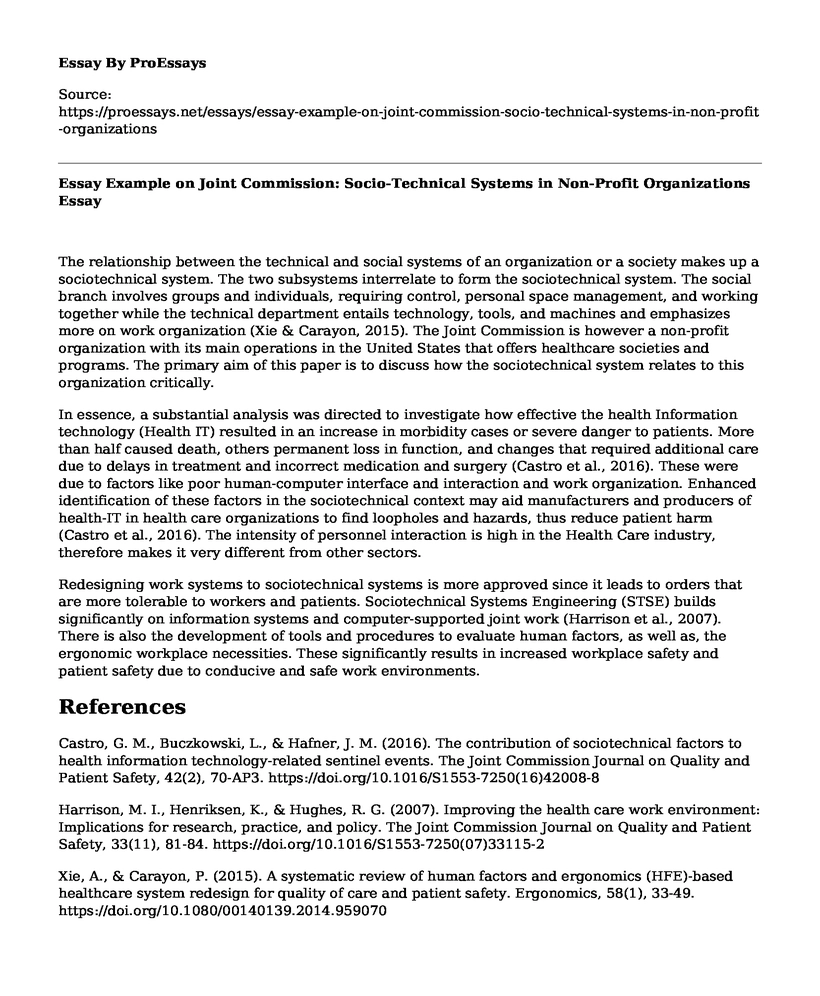The relationship between the technical and social systems of an organization or a society makes up a sociotechnical system. The two subsystems interrelate to form the sociotechnical system. The social branch involves groups and individuals, requiring control, personal space management, and working together while the technical department entails technology, tools, and machines and emphasizes more on work organization (Xie & Carayon, 2015). The Joint Commission is however a non-profit organization with its main operations in the United States that offers healthcare societies and programs. The primary aim of this paper is to discuss how the sociotechnical system relates to this organization critically.
In essence, a substantial analysis was directed to investigate how effective the health Information technology (Health IT) resulted in an increase in morbidity cases or severe danger to patients. More than half caused death, others permanent loss in function, and changes that required additional care due to delays in treatment and incorrect medication and surgery (Castro et al., 2016). These were due to factors like poor human-computer interface and interaction and work organization. Enhanced identification of these factors in the sociotechnical context may aid manufacturers and producers of health-IT in health care organizations to find loopholes and hazards, thus reduce patient harm (Castro et al., 2016). The intensity of personnel interaction is high in the Health Care industry, therefore makes it very different from other sectors.
Redesigning work systems to sociotechnical systems is more approved since it leads to orders that are more tolerable to workers and patients. Sociotechnical Systems Engineering (STSE) builds significantly on information systems and computer-supported joint work (Harrison et al., 2007). There is also the development of tools and procedures to evaluate human factors, as well as, the ergonomic workplace necessities. These significantly results in increased workplace safety and patient safety due to conducive and safe work environments.
References
Castro, G. M., Buczkowski, L., & Hafner, J. M. (2016). The contribution of sociotechnical factors to health information technology-related sentinel events. The Joint Commission Journal on Quality and Patient Safety, 42(2), 70-AP3. https://doi.org/10.1016/S1553-7250(16)42008-8
Harrison, M. I., Henriksen, K., & Hughes, R. G. (2007). Improving the health care work environment: Implications for research, practice, and policy. The Joint Commission Journal on Quality and Patient Safety, 33(11), 81-84. https://doi.org/10.1016/S1553-7250(07)33115-2
Xie, A., & Carayon, P. (2015). A systematic review of human factors and ergonomics (HFE)-based healthcare system redesign for quality of care and patient safety. Ergonomics, 58(1), 33-49. https://doi.org/10.1080/00140139.2014.959070
Cite this page
Essay Example on Joint Commission: Socio-Technical Systems in Non-Profit Organizations. (2023, May 08). Retrieved from https://proessays.net/essays/essay-example-on-joint-commission-socio-technical-systems-in-non-profit-organizations
If you are the original author of this essay and no longer wish to have it published on the ProEssays website, please click below to request its removal:
- Essay on Code of Ethics and Decision-making in Healthcare
- Epidemic of Mental Health Issues in Youths of Affluent Families Paper Example
- Problems Experienced by St. George Nursing Home Paper Example
- Persons Living With HIV Face Discrimination in Healthcare: Barriers to Access - Essay Sample
- Essay Example on Poorly Articulated Goals/Objectives: Impact on Public Health Programs
- COVID-19: A Deadly Respiratory Disease Spreading Fast - Essay Sample
- Essay on Urban Governance: Examining Diffuse Authority & Unspoken Conventions







